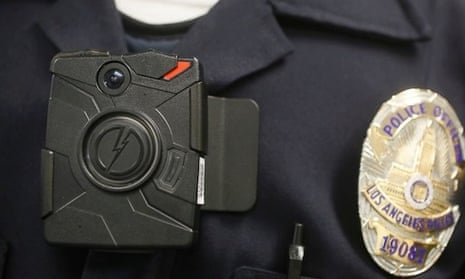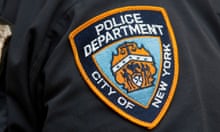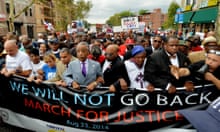Had the death of 43-year-old Eric Garner not been caught on film, calls to outfit New York Police Department officers with cameras might have quietly faded. Instead, a bystander captured Garner locked in a chokehold as he repeated: “I can’t breathe.”
Garner’s encounter with police – ruled a homicide by the New York city medical examiner – is not the only one that has resulted in visceral video. A driver captured a California highway patrol officer punching a woman repeatedly as she shielded her face with her arms. Two weeks after the video of Garner went viral, building residents filmed the NYPD dragging a Brooklyn grandmother out of her apartment in her underwear.
On Monday, the public advocate of New York, Letitia James, called on the city’s police department, once again, to begin a pilot program using the cameras. “We need action today,” she told a news conference. The NYPD, America’s most influential police department, confirmed that it is reconsidering the potential of such cameras.
Even as departments face scrutiny because of citizens’ videos, they are being pressed to adopt the technology themselves. Attempts to hold police accountable with video are not new, and neither is law enforcement’s distaste for being filmed. But the long history of avoiding the lens is bumping up against technology, as strapping cameras to officers themselves is increasingly considered good policing practice.
“We’re at the very beginning of something that could be very, very big,” said Sydney Siegmeth, spokesman for Taser International. The company produces the now-standard weapon that delivers a stunning electric shock, and recently waded into the body-worn camera market with the Axon. “I think more and more you’re going to see officers with technology on their body,” she said.
The company’s camera sales shot up by more than five times over the past year. Contracts increased to nearly 5,000 cameras and $11.3m in sales last quarter. More than 1,200 law enforcement officers now wear the cameras. The company regards all of the 18,000 police departments in the United States as a potential market for the technology – as well as private security guards, corrections officers, police forces outside the US and even municipal employees.
Civil libertarians have already signed off on police-worn camera programs, making it one of the few circumstances in which the organizations are calling for more, not less, surveillance.
“It serves more as a form of checks and balances against police power than it does for the government [control] over individuals,” said Jay Stanley, senior policy analyst at the American Civil Liberties Union.
“There needs to be very strong [privacy] protection, but at the same time we also see large numbers of very abusive Swat raids,” he said. “So it’s vital to have [cameras]”.
The most cited study of the effects of body-worn cameras on policing is Cambridge University’s examination of the police department in Rialto, California. After cameras were introduced in February 2012, officers’ use of force dropped 59%, and complaints against officers plummeted by 88%.
“When you know you’re being watched you behave a little better. That’s just human nature,” Rialto police chief Tony Farrar told the Guardian at the time. The Rialto Department has become the poster-child for early adoption, as metro agencies in San Diego, Los Angeles and Fort Worth begin pilot programs or deploy the technology.
Nevertheless, reluctance remains.
“It would be a nightmare,” former New York City mayor Michael Bloomberg told the press after a ruling on the city’s “stop-and-frisk” laws, almost exactly one year ago, in which judge Shira Scheindlin ordered that the department start a one-year pilot using the cameras in five precincts.
“We can’t have your cameraman follow you around and film things without people questioning whether they deliberately chose an angle, whether they got the whole picture in.”
Rialto police captain Randy De Anda said the NYPD sent two senior officials to his department in the last two weeks. Perhaps it shouldn’t be a surprise the officers went to California – New York police commissioner Bill Bratton’s last position was in Los Angeles, and he has voiced his support for the cameras in the past.
“They’re really seriously thinking about it,” said De Anda. A spokesperson for the NYPD said the department is “exploring and evaluating the technology”.
James said on Monday it would cost the NYPD about $5m to outfit 15% of the force’s 23,000 patrol officers. Her analysis didn’t address the cost of processing the vast amount of data the cameras generate. By contrast, she said, last year the department paid out $152m to settle complaints brought against it.
But lawsuits documenting officers’ distrust of cameras stretch back to 1977. At the time, a legal agreement required the NYPD to include a new passage in its patrol guide on citizens’ right to document public police activities. Just last weekend, the department issued a reminder to officers that citizens may legally film them.
In June, police in Suffolk County, New York, settled a lawsuit with the National Press Photographers Association (NPPA) after an officer arrested a television news cameraman for filming.
“Go away,” the officer told the cameraman. “I’ve been doing this for 30 years: there’s nothing you can hold over my head,” he said, before arresting the cameraman. Taxpayers footed the $200,000 bill when the department lost in court.
“It’s hard for me to understand why, if officers are acting appropriately, they wouldn’t want a tape, an audio-visual recording of what they’re doing,” said Mickey Osterreicher, general counsel for the NPPA, which sued Suffolk County on the cameraman’s behalf.
“There are far too many officers that operate under the theory of: ‘Because I said so.’”
Law enforcement officials do not appear deterred by the long history of court losses.
An Illinois eavesdropping law, designed to protect people’s privacy, was used to prosecute a woman after she recorded officers trying to dissuade her from filing a sexual harassment complaint against a fellow officer. Charges were eventually dropped.
The law made audio recording an officer without their knowledge, even in public and on duty, a felony, punishable by 15 years in prison. The law was declared unconstitutional in 2012. In Massachusetts, an anti-wiretapping law bars the public from audio-recording an officer without their knowledge. It is also a felony.
Photography has also been maligned. One myth circulating in the law enforcement community is that photography is a “precursor behavior” for terrorism, even though security experts have called it “nonsense”.
Nevertheless, private security guards and other pseudo-law enforcement agencies can use such behavior to file “suspicious activity” reports that stay in federal databases as long as 30 years, and are accessible to local and state police.
Deploying police with body-worn cameras raises a host of legal questions. How long should law enforcement keep the videos? Will all videos or just evidentiary videos be kept? How much latitude should officers have when determining whether to activate the cameras? What happens when they disregard those policies? It’s unclear if the videos would be public record – De Anda says no, Osterreicher says yes. And what would it mean for so many law enforcement agencies to pay private companies, such as Taser, to handle evidence?
According to De Anda, officials who’ve come to see Rialto’s camera program are generally interested in using the technology, but are constrained by budgetary limitations. The two models made by Taser, one for the glasses and one for the chest, cost between $399 and $599 apiece, not including access to Evidence.com. Taser will also manage the data for departments, and claims it’s more cost effective than in-house solutions. That costs between $15 and $55 per month, per user.
“I haven’t heard anything negative other than it might not be cost effective,” said De Anda. “As time goes on as the technology progresses it’s going to be very, very affordable for law enforcement agencies”.
Rick Smith, CEO of Taser International, says the agencies make up the cash in reduced lawsuits and complaints. Not stopping there, Smith wants to make police reports themselves obsolete.
“Why would we have officers sit down and waste time writing about it?” said Smith. “Ten years from now every cop will wear a camera, which will mean a much more smooth and transparent relationship with the community, and every officer will be out doing police work instead of doing administrative work.”
The ACLU’s blessing of the technology is a caveated one, however.
“The challenge of on-officer cameras is the tension between their potential to invade privacy and their strong benefit in promoting police accountability,” wrote Stanley in a 2013 ACLU white paper. “Overall, we think they can be a win-win – but only if they are deployed within a framework of strong policies to ensure they protect the public without becoming yet another system for routine surveillance of the public”.






Comments (…)
Sign in or create your Guardian account to join the discussion